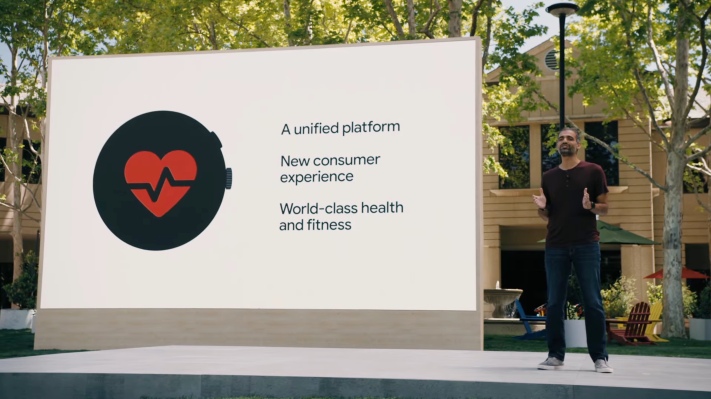Everything old is new again. Someone leaves a prototype in a bar, prototype makes its way into some blogger’s hands, chaos ensues. It’s hard to imagine another device coming along soon that’s shrouded in the same layer of security as the iPhone 4. Both gadgets and tech journalism have evolved since those halcyon days, but nothing like a high-profile leak to get the blood pumping in these old typing fingers.
Companies’ protect-the-IP-at-all-cost approach has shifted, too, over the past decades. Plenty of firms have come to understand the power of well-timed leaks. That’s not to say that any of the Pixel Watch news we’ve seen in recent weeks and months has been intentional — it’s just hard to imagine any of us saying much about an upcoming Google wearable if some information hadn’t found its way online.
The weekend’s restaurant leak comes a few days after a trademark application for “Pixel Watch” popped up online. The timing of everything seems to point to the imminent announcement of the moderately anticipated wearable. Given that I/O kicks off at the Shoreline Amphitheater in just over two weeks, it seems reasonable to infer that — at the very least — we’ll be getting a taste in mid-May. Google really needs to make a splash here.
Google’s history with wrist-worn wearables has been — in a word — spotty. It’s been 7.5 years since the company launched Android Wear. The product arrived with plenty of hardware partners — companies like Motorola, Samsung, LG and HTC. Honestly, it’s a pretty good snapshot of the Android ecosystem, and fittingly two of those four have either stopped making phones or at least gotten close.
Samsung drifted away from Android Wear fairly quickly — opting instead to develop its own unique flavor of Tizen. More recently, Motorola has moved to Moto Watch OS for its latest device — it’s a lightweight RTOS (real-time operating system) similar to what OnePlus uses on its watches.
Google’s wearable operating system continued to stagnate for a number of years, as Apple — and to a lesser extent Samsung — dominated the smartwatch category. In 2018, however, it got a rebrand. Wear OS represented a shot at a free start. “We’re just scratching the surface of what’s possible with wearables and there’s even more exciting work ahead,” the company wrote in a post.
The change didn’t result in a massive shift in market share — though a number of more recent moves have helped move the needle. Most notable thus far is a reunion with Samsung. “The new Wear OS Powered by Samsung” finds the firms joining forces in a bid to go toe to toe with Apple, starting with the Galaxy Watch 4. For Samsung, it means access to a Play apps. Third-party support has long been a major sticking point for the industry. For Google, it means suddenly having their operating system on a LOT more devices.
Samsung was doing perfectly fine, thank you very much, on the wearable front without Google’s help. Granted, it wasn’t going to surpass the Apple Watch any time soon, but the company still sells a lot of devices. I suspect the onus was on Google to convince the hardware company that it was still all-in on Wear OS. One thing you can’t deny is that the software giant is more than willing to spend its way to the top here. You’d be forgiven for forgetting that Google purchased Fossil’s smartwatch technology in early 2019.
“Wearables, built for wellness, simplicity, personalization and helpfulness, have the opportunity to improve lives by bringing users the information and insights they need quickly, at a glance,” Wear OS VP Stacey Burr said at the time. “The addition of Fossil Group’s technology and team to Google demonstrates our commitment to the wearables industry by enabling a diverse portfolio of smartwatches and supporting the ever-evolving needs of the vitality-seeking, on-the-go consumer.”
I now realize I started that specific post with the words, “Rumors about a Pixel Watch have abounded for years.” That puts a fine enough point on precisely how long we’ve been talking about the damn thing.
That specific deal was soon eclipsed by Google’s $2.1 billion Fitbit acquisition. The deal passed regulatory scrutiny, in spite of some reasonable concern over what Fitbit’s new partner would be doing with the massive volumes of data these devices collect.
“This deal has always been about devices, not data, and we’ve been clear since the beginning that we will protect Fitbit users’ privacy,” Google SVP Rick Osterloh noted at the time. “We worked with global regulators on an approach which safeguards consumers’ privacy expectations, including a series of binding commitments that confirm Fitbit users’ health and wellness data won’t be used for Google ads and this data will be separated from other Google ads data.”
Now this technological turducken goes even deeper. Fossil acquired Misfit in 2015 for $260 million. Fitbit, struggling to expand into smartwatches, purchased Pebble’s assets for $20.3 million the following year. Honestly, it was a bargain, and it actually resulted in a great smartwatch with the Versa. Ultimately, however, it seems it was too little, too late as Fitbit opted to sell itself to Google.
Certainly, we’ve got the ingredients for something exceptional here. Given the recency of the Fitbit acquisition, it’s hard to know exactly how much of its tech would make it into a first-gen Pixel Watch. It stands to reason, however, that the subsidiary’s strong health focus will play a central role in Google wearables, going forward. The company’s still developing some important stuff, including a new always-on A-Fib detector.
All of this comes together as Google has revamped its first-party hardware. The Pixel division underwent a reckoning/restructure after years of middling sales. That gave us the truly excellent Pixel 6. Thing is, Pixel phones have always been pretty good, even if their sales haven’t reflected it. Google’s not starting from scratch here, exactly (not if you count all the work Timex and Fitbit, et al. have done), but we are effectively talking about a new category for the company, so it’s worth tempering your expectations accordingly.
So we’re left with a prototype left at a bar. It’s round, with a glass back and a crown that appears to function similarly to the Apple Watch. The device sports a proprietary band and a pair of buttons around the edges. It’s likely a prototype, but all of that comports with earlier rumors and the tale of a bartender who was holding onto the product for a customer who apparently never came back for the thing.
Assuming we’ve got about two and a half weeks for the announcement, that gives us all enough time to craft some think pieces about whether the Pixel Watch is too little and/or too late. Google has already bought its way into a significant portion of wearable marketshare with the Fitbit acquisition, but it’s once again entering a mature and crowded market — something it struggled to maintain with the first several generations of Pixel phones.


